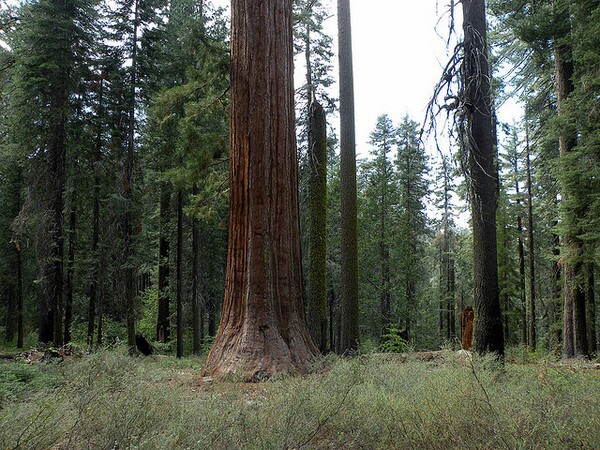Another Reason to Leave Ancient Trees Alone

In case you needed one more reason to preserve old-growth forests, a paper published Wednesday in Nature offers a good one: very old trees may remove more carbon dioxide from the atmosphere than young and middle-aged ones.
The study by 38 forest scientists examined growth rates of more than 670,000 individual trees of 403 species around the world, including many from California. The results were almost uniform across the board and around the world: the bigger trees get, the faster they grow and the more CO2 they take out of the atmosphere.
It's a counterintuitive finding, given the widespread perception that very young trees grow far more quickly than their ancient relatives. And though the authors point out that it's not a slam-dunk conclusion that ancient forests offer more help to our climate problems than stands of newly planted trees, the study should definitely give pause to those who suggest timber harvests can be used to control climate change.
Of the 403 tree species examined worldwide, 96.8 percent had growth rates that increased the larger the trees in question were. The numbers for North American tree species studies were even more striking: 110,153 trees of 89 species were measured, with 98.9 percent of the species showing the "big old trees grow faster" pattern.
On average, a tree with a trunk a meter thick (about 39 inches) can be expected to add about 103 kilograms, or 227 pounds, of dry matter to its overall mass each year. Trees of that size in the Western U.S. examined in the study accounted for a third of the biomass increase in their local forest stands, even though they made up only about six percent of the total population of individual trees.
The biggest trees examined were members of two species: ancient redwoods of the northwestern California coast, and Eucalyptus regnans, native to the Australian states of Victoria and Tasmania. The largest individuals of those species added as much as 600 kilograms, or 1,322 pounds, of dry matter to their mass each year.
Dry matter is that part of a plant's tissues that remains after all the water is removed. About half the dry matter in a typical forest tree is carbon. A molecule of carbon dioxide, made up of a carbon atom and two oxygen atoms, is three and two thirds the mass of a carbon atom. This means that for every 100 kilograms of dry matter added by a large forest tree, somewhere in the neighborhood of 183 kilograms of CO2 has been taken out of the atmosphere and turned into tree.
(To put that into climate perspective, the typical American automobile puts about .44 kilograms of CO2 into the atmosphere per mile driven.)
Strikingly, the relationship between tree size and tree growth rates for most species examined seems to be linear, meaning that as long as a tree is alive it just grows faster and faster.
"This finding contradicts the usual assumption that tree growth eventually declines as trees get older and bigger," says lead author Nate Stephenson, a forest ecologist with the U.S. Geological Survey (USGS). "It also means that big, old trees are better at absorbing carbon from the atmosphere than has been commonly assumed."
California tree species examined other than coast redwoods included Pacific silver, white, and red firs; sugar, lodgepole, and ponderosa pines; Sitka spruce; Douglas fir; quaking aspen; western incense cedar; and western and mountain hemlocks.
The study doesn't necessarily establish that old-growth forests are better at taking up CO2 than their younger counterparts. "Old trees, after all, can die and lose carbon back into the atmosphere as they decompose," says the USGS's Adrian Das, a coauthor of the study. "But our findings do suggest that while they are alive, large old trees play a disproportionately important role within a forest's carbon dynamics. It is as if the star players on your favorite sports team were a bunch of 90-year-olds."
Previous studies have suggested that ending timber harvests on public lands in the U.S. could offset about 1.5 percent of the nation's greenhouse gas emissions over the next several decades. Given the startling results of Wednesday's study, that figure may need to be nudged upward.


